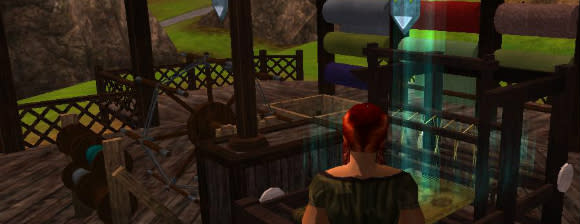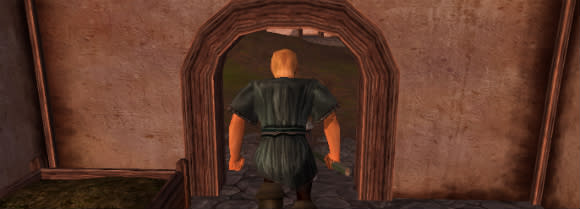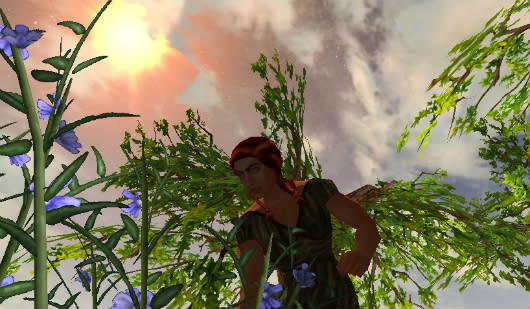Rise and Shiny revisit: Istaria
At this point it's a sure thing for me to revisit Istaria, the old-school MMO by Virtrium, every single year. I look forward to it each time even though the game always feels basically the same. I don't want to imply that the game doesn't change at all. In fact, the indie developer team that works to run the game should be proud of the frequency of communications and patches. Around seven patches (large and small) were applied to the game in the month of December alone. On the surface, however, the game largely plays the same way and features the same systems that it always has. That doesn't mean I am familiar with them all or have come anywhere near mastering them all, but it's a comfort to know that the game remains familiar to those who are returning after some time away.
The team added a larger patch in December called Crystalshaper. The game also turned 10 years old, a feat in itself. I thought that now would be a perfect time to take another look at it, and I even ran a livestream of the game, co-hosted by Lead Designer Jason Murdick.

Let's cover Crystalshaper first, especially because it is the prime reason I came back to the game this time around. If you weren't aware, there are 11 playable races in Istaria: Half-Giants, Sslik, Elves, Dryads, Dragons, Satyrs, Saris, Dwarves, Fiends, Gnomes, and Humans. If you noticed (and I have a feeling you did), there are dragons to play in Istaria. Dragons are easily the most attractive thing about the game. The feeling of flying around and controlling a fire-breathing beast is pretty cool, cool enough to attract new players to this decade-old game. I would go so far to say that the developer team appears to favor the dragons, but the other races are full, detailed, and interesting as well. Dryads are a fairy-like race, while the Satyrs are goat-legged characters, for example. There's really something for everyone in the game.
It's important to note that Istaria has a unique payment model. You can play a Human for free with no restrictions (other than owning a house), but to play as any of the other races, you will need to subscribe. Sure, it's an innovative-yet-dated payment model, but it appears to work out in the end. After all, the game is getting more patches and communication than games half its age.
Back to dragons and the new patch. A Crystalshaper is a new form of crafter. The knowledge of crystalcrafting was lost, and it's the player's job to rediscover it. Players with a high-level dragon will visit a new zone, the Fiery Rift, after completing a series of quests. Once there, they will meet up with Aratanosh to start the long journey to becoming a Crystalshaper. The crystals that the player will create give out bonuses during combat, and the raw materials to form the crystals -- Sliver of Emotions -- are dropped by mobs. The crafter needs the adventurer to go out and get the Slivers, and the adventurer needs the Crystalshaper to make the crystals.
Watch live video from Massivelytv on TwitchTV
I started the series of quests needed to become a Crystalshaper but quickly realized just how difficult they would be for someone who doesn't not know everything that is needed to perform well in combat. This week my dragon character was a loaner, and some helpful players tried to help me understand how to gain more DPS and how to kill the monsters I needed for the Crystalshaper quests.
According to Jason, the Crystalshaper questline consists mostly of killing some form of mob, from boss monsters to smaller creatures. I've heard from many members of the community over this last week, most of whom told me that the game definitely leans on grinding. I have always found the game pleasantly slow, but I have also never been one to attempt to max out a character in a short period of time. To me, Istaria and the new Crystalshaper content feels appropriately grindy, meaning that the grind did not surprise me because I have had experience with the game.
I wanted to make a new character and concentrate on crafting a bit more this time around. The game features a nice beginner tutorial island that explains most of the basics you need to know in order to make your way through the game. Sure, there's a lot of reading, and it can be quite taxing to take it all in, but by the end of the tutorial (I run through it every time), I always feel as if I learned something new (or at least refreshed the basics that I forgot over the last year).
Crafting in Istaria is relaxing. I got into a discussion on crafting in the chat and was pleased to find out that there are players who almost completely concentrate on crafting. At some level, gaining higher-level resources requires some amount of combat experience, but more than one player told me how gaining levels in crafting just means gaining some ability to defend yourself. Still, it would be wise to hire a bodyguard or to simply buy the higher-level goods if needed. I agree with the design. After all, if someone decides to cast aside combat training to further a career in crafting, that person should not expect to also be good at fighting.
Crafting basically consists of learning new "recipes" or plans, gathering the raw materials needed, refining those materials, and using them to create the item. Tools are needed, as is access to crafting stations like a loom or anvil. To me, the thrill that comes from crafting in Istaria is not due to its originality or quickened pace. I enjoy it because it is usually relaxing and interesting to watch.

Istaria is still a fascinating MMO because of its subtle, unique designs that make it stand out from other older MMOs. Developers have had to consider the size difference between all of the races -- from the tiny Dryad to the massive dragons -- and incorporate that into the game's design. I played a half-giant this week and loved the fact that I had to literally crouch down to make it through some doorways. Dragons, by the way, gain an ability to change size and shape in order to fit into parts of the humanoid world. The newer school of MMO design seems to say that all players and races need to be treated equally in-game, leading to games that feature different classes and races that are often blandly and perfectly balanced. Istaria seems to favor some races and abilities. I like that variety and lack of perfect balance.
The game is still much too grindy for my taste, however. I enjoy playing it for a while and exploring the different races and activities, but I cannot stomach killing so many monsters for such a long time. The good news is that Istaria offers some fantastic roleplay opportunities and enough interesting gameplay to keep explorers happy. If you want to gain levels and become more powerful, the best idea is always to group up with more experienced players. Vets helped me more over this last week than I ever expected.
The game is definitely starting to age. Give it some time, however, and your super-resolution-sensitive eyes will become used to the sights and sounds of this older game and it will actually start to look quite nice, and the variety of character and gameplay styles will suck you in. There are 27 adventurer schools and 19 crafting schools! And although a player can have only one adventurer and one crafting school active at a time, it's possible to switch classes by visiting a trainer. It's not quite an open sandbox, but it sure can feel like it.
It's good to see that Istaria is still moving along. Could it go for another 10 years? Possibly, and why not?
Next week I will be looking at a quiz-based, browser-based MMORTS (yes, seriously) called Brain Storm. If it sounds interesting to you, check out my livestream on Monday, the 6th of January, at 4:00 p.m. EST, right here on our livestream channel!

Each week on Rise and Shiny, Beau chooses a different free-to-play, indie, or browser-based game and jumps in head-first. It might be amazing or it might be a dud, but either way, he'll deliver his new-player impressions to you. Drop him an email, comment, or tweet!


